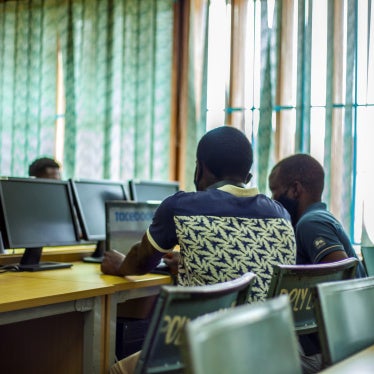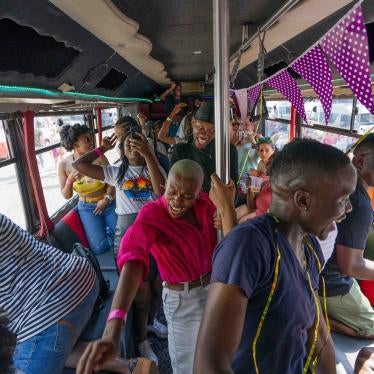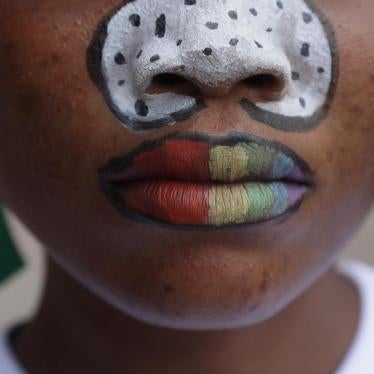(Johannesburg) – A recent mining accident that killed 16 people at an unlicensed artisanal gold mine in Ghana underscores the need for tougher measures to end child labor and protect the safety of adult artisanal miners, Human Rights Watch said today. Human Rights Watch visited the site of the mine collapse between May 31 and June 2, 2013.
On April 15, at around 6:45 a.m., a mud wall collapsed in a large open pit at a gold mine where over 20 people were working near Kyekyewere, Upper Denkyira East District, Central Ghana. A few of the miners were pulled from the mud with injuries, but 16 died. Among the victims was a 17-year-old boy named Abroso Kwabena Donkor, an orphan who had dropped out of school at 15 to work in the mines.
“Mining is one of the most hazardous types of work in the world,” said Juliane Kippenberg, senior children’s rights researcher at Human Rights Watch. “Ghana’s government needs to get children out of those mines and make it a priority to regulate the country’s artisanal gold mining.”
Human Rights Watch interviewed 20 members of the community near the site of the mine collapse, including 8 children who worked in or near the mine and 5 witnesses to the collapse, as well as government authorities in Upper Denkyira East district and the capital, Accra.
Children from nearby villages worked regularly at the accident site. Children as young as 12 carried and processed the ore and sold the raw gold they mined directly to local traders.
A third of Ghana’s children between the ages of 5 and 14 are working. A 2006 International Labor Organization (ILO) study found that about 10,000 children were working in the country’s artisanal gold mines. Children who work in artisanal gold mining risk ill-health or accidents from deep falls into pits, collapsing pits, flying rocks or shard, dangerous tools and machinery, continued exposure to dust, transport of heavy loads, and the use of toxic mercury.
Twelve-year-old “Ibrahim” described to Human Rights Watch how he carried heavy ore and processed it with mercury. Asked whether he liked this work, Ibrahim said, “I don’t like mining anymore because of the way people are dying.”
Under Ghanaian law, work in mining is explicitly prohibited for anyone under 18. Ghana has ratified international standards on child labor, including ILO Convention 182 on the Worst Forms of Child Labor. Although the government has developed an action plan and put in place a national steering committee to address child labor, such efforts rarely reach the artisanal mines. The few programs that address child labor in mining are run by international agencies and nongovernmental organizations and are limited in scope.
“The government should inspect licensed and unlicensed mines for child labor,” Kippenberg said. “Children risk their lives in these mines.”
In addition to accidents, children risk ill-health and permanent disability from exposure to toxic mercury used for gold processing. Mercury attacks the central nervous system and is particularly harmful to children. Mercury is added to the ore to create a gold-mercury amalgam, and then burned off, releasing toxic vapor and leaving the raw gold behind.
Children in the Kyekyewere area told Human Rights Watch that they handled mercury on a regular basis. An adult miner commented on the work of children at the accident site:
The children wash the mineral. They are all boys. They do the processing with the mercury. They know the work better than the older ones.
The trade and use of mercury for mining is legal in Ghana, despite international efforts to reduce mercury use. In January 2013, governments around the world agreed on a new international treaty seeking to reduce the harmful effect of mercury globally, the Minamata Convention. Human Rights Watch urged the government of Ghana to sign and ratify the Minamata Convention, and to take urgent steps to reduce, and where feasible eliminate, mercury use in mining.
International human rights law compels Ghana’s government to protect its citizens from abuses, including those connected with mining activity. Around the world, evidence has shown that without effective government regulation, mining operators and companies will not consistently behave responsibly.
“This recent accident shows how a government that fails to properly regulate mining activity can end up creating a fertile ground for death, injury, and abuse,” Kippenberg said. “The Ghanaian government needs to sanction those who employ children, run unsafe mining operations, or fail to rehabilitate sites.”
For details about artisanal gold mining in Ghana, child labor in mining, and the events at the mine near Kyekyewere, please see below.
For more Human Rights Watch reporting on Ghana, please visit:
https://www.hrw.org/africa/ghana
For more Human Rights Watch reporting on child labor, please visit:
https://www.hrw.org/topic/childrens-rights/child-labor
For more Human Rights Watch reporting on the dangers of mercury, please visit:
https://www.hrw.org/dangers-of-mercury
For more Human Rights Watch reporting on the environment, please visit:
https://www.hrw.org/topic/environment
Artisanal and Small-Scale Gold Mining in Ghana
An estimated one million people work in artisanal mining – or galamsey, as it is called in Ghana. In recent years, the country has seen a boom in illegal artisanal and small-scale mining due to high gold prices and the influx of foreign, particularly Chinese, investors and miners, who have helped set up small mines with heavy equipment. This has in turn increased artisanal mining activities by locals – including children – who enter these mines to dig for gold. Illegal gold mining has contributed to the pollution of Ghana’s water and the destruction of its rainforest.
The government Minerals Commission processes mining licenses and seeks to enforce regulations on licensed, legal mines. However, it has largely failed to curb illegal mining. District authorities in Upper Denkyira East said that they often do not even know where the mines are. The government recently decided to crack down on the illegal mines, and in early June arrested Chinese miners in connection with this effort.
The Kyekyewere mining accident occurred at an illegal mine – one without a valid license – run by a Ghanaian miner and a Chinese businessman. They used an excavator to dig deep into the ground, and failed to rehabilitate the mine after abandoning it, leaving an open pit. Although the site had security guards, villagers were able to enter and start mining. The Ghanaian miner was briefly detained by the police after the accident, but has been released.
The Accident Site
Child laborers told Human Rights Watch about their work in artisanal mining on the accident site near Kyekyewere or at other nearby mines. They carried ore from the pit to the processing place, panned and washed the ore, and used mercury to retrieve the gold. They said they usually went in groups on their own initiative, and used the money to buy desired items such as clothing, or gave the money to their family. Fortunately, few children were at the mine on the morning of the accident.
Human Rights Watch spoke to 17-year-old “Paul,” a child laborer who was working in artisanal gold mining full-time, and who witnessed the accident. He described the situation that morning:
I went there early in the morning. But when I got there, the security guards were doing mining. They did not allow us to work there. As we were struggling to convince them to let us work there, older miners arrived and convinced them we can work. There was an exchange between them. We stayed behind and watched. The older miners went into the pit. All of a sudden I saw the mud has covered the people in the pit…. As soon as it happened, police came and joined in the rescue. All the miners were told to go home.
Among those who died was Abroso Kwabena Donkor, an orphan who had been living with his maternal aunt after his mother’s death. Abroso had dropped out of school after 6th grade and had worked in artisanal gold mining full-time since the age of 15. He was working at the mine with his aunt and uncle, who survived with injuries.
Another victim was Clement Abugiri, 19, a high school student. He had gone with his mother to dig for gold to pay his school fees; both died in the mine collapse. Clement’s sister told Human Rights Watch in tears that he was a “brilliant boy” who had gone further in education than anyone else in the family. He had even skipped a grade in high school, despite having suffered a prolonged illness.
Other residents, including a 13-year-old child laborer, confirmed that children sometimes work in artisanal gold mining to earn money for school supplies or fees.
Children from the nearby villages of Amoafo and Badoa regularly worked at the site where the accident occurred. “Wilson,” 14, described his work with toxic mercury:
Because the gold is in the mud, it is scattered. I pour the mercury on it and it brings the mineral together. It forms into one. I wash the mud out with the water…. I do this with bare hands. I squeeze the water out with a rug. Then I burn it. I take an [empty] can of tomato paste and put it in a fire to burn [the amalgam]. After I finish, the yellow colors come out…. I don’t protect myself. I have been told when mercury enters your mouth it is poisonous and you can die.
One 12-year-old boy, “Ibrahim,” who showed Human Rights Watch the mobile phone he had bought with proceeds of the gold he mined, said:
I am in 4th grade in primary school. I collect the mud. I bring a pan to those digging, and they fill in the mud, and I take it to those doing the washing. I go there during weekend and vacation. I am paid about 10-15 cedis [approximately US$5-7.50] a day. I also do the washing [processing] sometimes. I work with mercury. I mix it into the ore. I have also done burning [of the amalgam]. We buy the mercury. Or the buyer gives it.
Fifteen-year-old “Kofi” told Human Rights Watch that he had been working in artisanal gold mining since he was 12 or 13, and that he often skipped school to go to the mine instead. When he started mining work, he carried the mud from the pit to the processing site, causing serious back pain. He switched to processing the mineral, regularly working with mercury. Asked whether he will continue this work after the accident, he said, “I cannot stop this work.”








